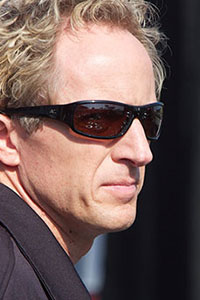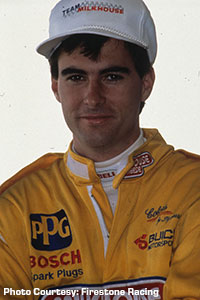Second of three parts on the 30th season of Indy Lights competition
Periodically, between production meetings and news-gathering at Mid-Ohio Sports Car Course last month, NBCSN Verizon IndyCar Series reporter Jon Beekhuis avidly followed the Mazda Road to Indy on-track action.
The three levels of the development ladder – Cooper Tires USF2000 Powered by Mazda, the Pro Mazda Championship Presented by Cooper Tires and Indy Lights Presented by Cooper Tires -- contested seven races over the weekend on the challenging road course.
The level of competition and race craft in the two Indy Lights races – the penultimate round of the season – especially caught Beekhuis’ attention and transported him to another time.
Click it: Indy Lights an important part of driver development
“Without a doubt, I wouldn’t be where I am today without Indy Lights,” said Beekhuis (photo, left), the 1988 series champion. “Back in that era there were only a few ‘spec’ series, which gave us a shot to race on equal footing with the ‘big boys’ even without a major sponsor.
“I loved that there were no ‘if I only had this engine or that chassis’ excuses and the results were in your hands. That raises everyone’s game, and I believe it’s been a key to Indy Lights' incredible success as a driver development series.
 “My prize for winning the championship was supposed to be an Indy car rookie test with (series founder) Pat Patrick’s team, but they were busy at the time with some guy named Emerson Fittipaldi. My test was eventually handed off to Tony Bettenhausen’s small team, which actually turned out to be a great blessing.”
“My prize for winning the championship was supposed to be an Indy car rookie test with (series founder) Pat Patrick’s team, but they were busy at the time with some guy named Emerson Fittipaldi. My test was eventually handed off to Tony Bettenhausen’s small team, which actually turned out to be a great blessing.”
“Tony liked what he saw at the test, found a sponsor and put me in his car for my Indy car debut in Toronto 1989. As the saying goes, the rest is history.”
Others champions in the initial 15 years included Bryan Herta, Paul Tracy, Eric Bachelart, Robbie Buhl, Tony Kanaan, Greg Moore, Cristiano da Matta, Oriol Servia, Scott Dixon and current NBCSN Verizon IndyCar Series analyst Townsend Bell.
“Apparently it’s also a training ground for announcers,” Beekhuis added. “I’ve also worked with fellow grads Calvin Fish, Johnny O’Connell, Justin Bell, James Hinchcliffe, Robbie Buhl, Wally Dallenbach Jr., Josef Newgarden and Anders Krohn. Not sure if this is an intended consequence, but that’s quite a group.”
Newgarden, a two-time race winner this season in the Verizon IndyCar Series, was the 2011 Indy Lights champion. Additionally, Tristan Vautier (2012), Sage Karam (2013) and Gabby Chaves (2014) are Indy Lights champions who competed in the Verizon IndyCar Series this year.
Chaves earned the Sunoco Rookie of the Year award driving for the Verizon IndyCar Series team owned by Herta, who also is an Indy Lights team owner.
On Sept. 13 at Mazda Raceway Laguna Seca, the series will crown its latest champion, who will receive a $1 million scholarship and three-race guarantee in the 2016 Verizon IndyCar Series season.
 “Indy Lights was such a great time in my career and it was really where I grew up and transitioned from amateur to professional,” said Herta ('93 photo, right), the 1993 Indy Lights champion who went on to win four Indy car races. “I can’t think about my time in Indy Lights without thinking about Roger Bailey, who was there from the beginning and nurtured it, and Pat Patrick, who founded it.”
“Indy Lights was such a great time in my career and it was really where I grew up and transitioned from amateur to professional,” said Herta ('93 photo, right), the 1993 Indy Lights champion who went on to win four Indy car races. “I can’t think about my time in Indy Lights without thinking about Roger Bailey, who was there from the beginning and nurtured it, and Pat Patrick, who founded it.”
Indy Lights competes at many of the Verizon IndyCar Series’ venues, providing the experience on and the continuity of the diverse schedule of road/street circuits and ovals. The Freedom 100 on the Indianapolis Motor Speedway oval – two days before the Indianapolis 500 Mile Race – is a highlight.
With a new chassis-engine package this season that includes technology such as push-to-pass, which is utilized in the Verizon IndyCar Series, driver development is even more in tune with the pinnacle open-wheel racing series.
“To being able to compete in it as a driver and then as a team owner and see how well it’s doing with the new car and Dan Andersen’s leadership, I think it’s a great series but also very necessary series for the Verizon IndyCar Series,” Herta said. “It’s the final preparation step before you race in IndyCar.
“It’s proven the test of time the number of drivers who have come out of Indy Lights into IndyCar. There isn’t another series that can boast the number of graduates into a top series. It does exactly what it’s intended to do.”